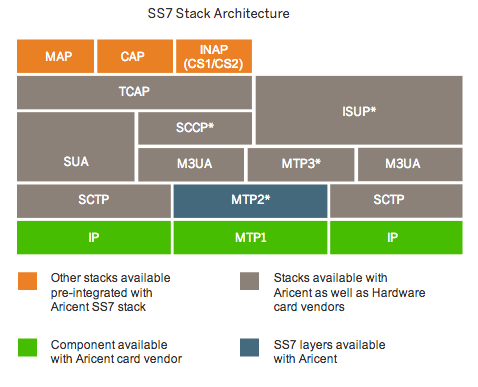SS7 and SIGTRAN
Protocols that deliver. Signaling System 7 (SS7) and SIGTRAN are a widely used family of signaling protocols for building highly reliable telecom systems. SIGTRAN is an IP-based evolution of SS7. Our protocol stacks help Communication Equipment Providers build highly differentiated, carrier-grade telecom products, while reducing costs and risk by avoiding the overhead of protocol stack development, maintenance and support.
SS7
Sysmetlab Signaling System 7 (SS7) software is an industry-proven protocol stack for building telecom network components, as well as SS7-based applications. Our SS7 software protocol stack is ideal for use in narrowband, broadband and next-generation IP networks.
Our SS7 protocol stack has been successfully integrated into a range of products, including:
- 3G Nodes (UMTS): Radio Network Controller (RNC), Serving GPRS support node (SGSN), Home location register (HLR)
- Voice over Packet: gateways and softswitches
- Interworking products (e.g., SS7-ISDN interworking)
- Short message service center (SMSC)
- Intelligent peripherals, service node and Service control point (SCP)
- Test and measurement tools (protocol testers)
- Monitoring tools
- Wireline trunk switches
The protocol stack offering includes all standards-based layers, which can be offered as individual layers or as an integrated protocol stack. The stack can also support hybrid stacks (ANSI TCAP over ITU SCCP/MTP), as well as reverse hybrid stacks (ITU TCAP over ANSI SCCP/MTP). The SS7 protocol stack is also available with value-added features such as high-availability, manageability and performance levels, making it suitable for carrier-grade deployments.
Our Message Transfer Part (MTP2) has been ported on various cards, chipsets and platforms such as Performance Technologies, Adax, AT&T Spyder T7115A, Motorola 860, 8260, 8266 and others. Sysmetlab also offers customized development for other target cards and chipsets.

Sysmetlab’s SS7 protocol stack has built-in hooks for supporting various redundant architectures. In addition to these hooks, Sysmetlab also provides an independent Redundancy Manager that can be used to build fault-tolerant SS7 solutions.
The MTP3, Signaling Connection Control Part (SCCP), Transaction Capabilities Application Part (TCAP) and ISDN User Part (ISUP) layers of the Sysmetlab SS7 protocol stack are also available in a distributed version that can be used for implementing distributed, load-sharing and reliable architectures.
Features
- Each layer of the SS7 architecture conforms to the applicable ITU-T, ETSI, ANSI and Bellcore standards
- To facilitate migrations to next-generation IP networks, Sysmetlab also provides pre-integrated “SS7 over SIGTRAN” frameworks
SIGTRAN
The SIGTRAN protocol stack from Sysmetlab includes the Stream Control Transmission Protocol (SCTP) and user adaptations SUA (SCCP user adaptation layer), M3UA (MTP3 user adaptation layer), M2UA (MTP2 user adaptation layer), M2PA (MTP2 Peer-to-Peer adaptation layer), IUA (ISDN Q.921 user adaptation layer) and Voice over Packet (VoP) software.
The SIGTRAN stack functions can be divided into SCTP stacks and protocol stacks for Adaptation Layers. SCTP is responsible for reliable signaling transport, streaming, congestion avoidance and control, bundling and un-bundling, multi-homing and association management, security and user-transparent fault management. The adaptation layers (M3UA, M2UA, M2PA, IUA and SUA) transport the signaling information from the corresponding signaling layers (MTP3, MTP2, Q.921 and SCCP) using SCTP services. Our SCTP stack supports various user adaptations including M3UA, M2UA, IUA, M2PA and SUA.
Features
- Flexible API invocation mechanisms, either function based (stack as library) or message based (stack as task)
- Portable, modular, easy to customize, MT safe (Multi Thread Safety) and run-time configurable
- Well-defined and documented interfaces to the stack (Application programming interface (APIs))
- Integrated, tested and verified with Sysmetlab’s SS7 protocol stack layers
- Supports all features needed by 3G networks
- Application Server Process (ASP), Signaling Gateway (SG) and IP Signaling point (IPSP) configurations
- Client and server support
- Single/Multi-threaded support for higher performance
- Redundancy support
- Complete Suite: SCTP, M3UA, M2UA, M2PA, IUA and SUA
- Scalability: Highly configurable run-time and compile-time capacity related options; moreover, the SIGTRAN protocol stack can be used as either a library with a client application or as an independent module communicating with multiple applications